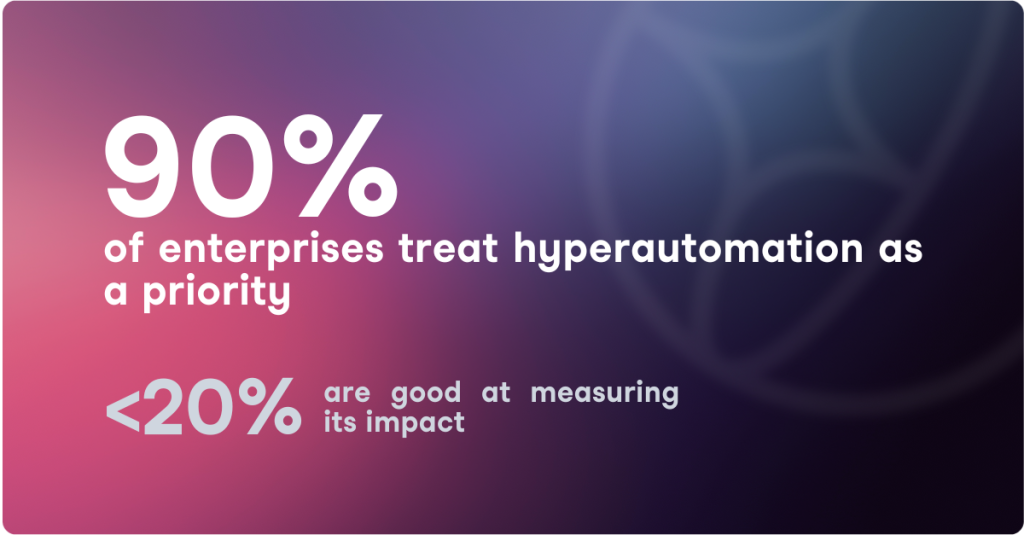Escrito por: Alejandro Fernández Publicado: 23/09/2025
Hyperautomation is the practice of combining multiple automation technologies, such as AI, process management, and integration tools, to transform how organizations operate.
The need for it is growing fast. Businesses face increasing complexity, fragmented systems, and constant pressure to deliver more with fewer resources. Traditional task-based automation helps, but it falls short when processes stretch across teams and systems. Gartner reports that while 90% of large enterprises treat hyperautomation as a priority, fewer than 20% are good at measuring its impact, underscoring the need for strong governance and proper instrumentation.
That’s why the focus is shifting from isolated bots to orchestrated workflows that run end-to-end, unlocking real efficiency and impact.

Hyperautomation is the coordinated use of technologies like automation, artificial intelligence, workflow management, and integration platforms to streamline and improve business processes. Instead of focusing on a single task or tool, it looks at how entire processes can be redesigned and run more efficiently from start to finish.
This makes it different from approaches like robotic process automation (RPA), which typically target single, repetitive tasks. Hyperautomation is broader and more strategic: it aims to connect people, processes, and technology so that entire workflows can run more efficiently.
At its core, hyperautomation is about strategy and orchestration: deciding what to automate, linking the right technologies together, and ensuring that everything works in a coordinated way.
Discover & prioritize
The first step is identifying which processes to automate. Process mining and data analysis reveal where the biggest gains are, whether in time saved, cost reduced, or errors avoided.
Automate & orchestrate
Once the right processes are chosen, technologies like AI agents, robotic process automation (RPA), workflow systems, and integrations come into play. The goal is not to automate tasks in isolation but to connect them into end-to-end workflows that run smoothly across teams and systems.
Govern & scale
To sustain results, organizations need rules and oversight. Governance means setting clear policies on data access, monitoring performance, and keeping a record of how automated decisions are made.
Hyperautomation is best understood through the results it delivers in everyday business settings:
Healthcare
Hospitals and service providers use automation to handle patient records and billing. By combining document processing, AI, and workflow automation, they cut down on manual data entry, reduce errors, and free staff to focus more on patient care.
Finance
Accounts payable teams often spend hours managing invoices and payment approvals. With hyperautomation, the process is handled end-to-end: invoices are captured, matched with purchase orders, routed for approval, and recorded in finance systems automatically. The outcome is faster payments, lower processing costs, and fewer mistakes.
IT and HR
Service desks are another area where hyperautomation makes an impact. Requests like password resets or employee onboarding tasks can be resolved automatically through integrated workflows. This reduces the number of tickets agents must handle directly and speeds up response times for employees.
Across these examples, the pattern is the same: organizations save time, reduce errors, and deliver faster, more reliable outcomes for both customers and employees.
One of the biggest hurdles in hyperautomation is system complexity. Modern processes often involve multiple layers of technology: data pipelines, analytics tools, integrations, and custom workflows all stitched together. As the number of tools grows, the overall system becomes harder to manage, making automation fragile and expensive to scale.
Another common issue is the lack of measurement and governance. Many organizations automate without clear oversight or a way to track results. Without metrics on speed, accuracy, or compliance, it is difficult to know if automation is truly delivering value or creating new risks.
Keeping complexity under control and putting governance in place are essential to make hyperautomation sustainable and valuable in the long run.
Hyperautomation is most effective when approached with focus: start with a specific process, track measurable results, and expand once the value is clear. The goal is not to automate everything, but to build sustainable improvements step by step.
At Maisa, we enable this with hallucination-resistant Digital Workers that handle end-to-end processes with full auditability. This ensures automation is not only fast and accurate but also reliable and transparent.